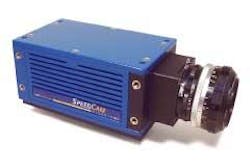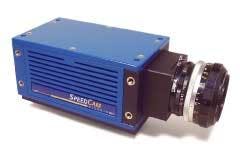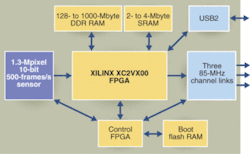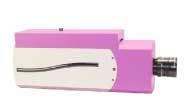High-speed cameras target motion-analysis applications
High-speed imaging systems provide researchers with valuable insight into the nature of fast events.
By Andrew Wilson, Editor
Fast mechanical processes, such as high-voltage discharges, crack propagation, and automobile-combustion experiments, demand fast image capture. Before the advent of digital imagers, such events were captured by high-speed, film-based cameras that required the event to be filmed, images developed, and images analyzed. Because of the time taken in the development process, high-speed events could not be immediately analyzed, resulting in a time-consuming procedure.
Now, however, digital CCD- and CMOS-based imagers are replacing high-speed film cameras as an effective means to study ultrahigh-speed phenomena or to troubleshoot costly industrial problems. Based around CCD and CMOS imagers, today's high-speed solid-state cameras can capture images at very-high data rates ([click here to]see table). Often achieving speeds of greater than 10,000 frames/s, solid-state cameras are now replacing film-based cameras in destructive high-speed product-testing applications, such as automobile-crash analysis, weapons testing, automotive assembly, and pharmaceutical packaging.
In choosing a high-speed camera for a specific application a number of technical factors should be carefully considered. These include the maximum frame rate of the camera, type of sensor used, spectral sensitivity, and whether images are directly transferred from the camera or stored for later, slower transfer. "Before selecting a high-speed camera, the speed and duration of the event and the resolution required to capture specific features must be fully understood. It is also important to know how much light is available and how much additional lighting will be necessary," says Tim Brandt, motion applications engineer at Redlake (San Diego, CA, USA).
CMOS Cameras
In CMOS-based cameras, digitizing partial frames from the imager may increase frame rates. In very-high-speed cameras, for example, rotating mirror systems can be coupled to multiple sensors. In high-speed, low-light-level cameras, CCD imagers are often fiberoptically coupled to image intensifiers, resulting in increased sensitivity. In early high-speed digital camera designs, CCD-based designs were almost universally used.
"Cameras featuring CMOS sensors offer the most flexible and least expensive solution to capturing images of high-speed events and are typically capable of exposures of 5 µs or less," says Brandt. "Intensified-CCD-based imagers are useful in extremely low light and when extremely short exposure times are needed. Rotating-mirror solutions are very expensive and are usually used for ultrahigh-speed events of very short duration, where only 8 to 16 frames are required," he adds.
Over the past three years, the emergence of CMOS imagers has heralded the development of a number of lower-cost, high-speed cameras that require fewer support circuits. These devices have allowed vendors to offer cameras that use windowing or partial frame readouts, resulting in a range of image-capture speeds at a variety of resolutions.
Recognizing the memory and interfaces required in these designs, camera vendors currently offer two types of high-speed cameras. Rather than support very-high-speed camera interfaces, some vendors have opted to place high-speed on-board memory in their cameras. In this way, image data can be captured—often for a few seconds at a time—on-board the camera and later read out for analysis though a standard interface such as Ethernet.
Capable of capturing images as large as 1536 × 1024, the SpeedCam Visario from Weinberger Vision Technology (Grand Blanc, MI, USA) was one of the first such designs (see Fig. 1 on p. 65). Created for the recording and analysis of rapid events, the camera uses a custom-built CMOS imager and an integrated memory for capturing image sequences up to 4 s. With an Ethernet interface, the camera can be integrated into applications where data can be remotely read over a network. In operation, subsampled 1536 × 1024 images can be digitized at rates as fast as 10,000 images/s.
Like Weinberger, Redlake also offers a high-speed camera, the MotionXtra HG-100k, designed to capture high-speed events in harsh environments. Based on a 1504 × 1128-pixel CMOS sensor, the camera captures 1000 frames/s into on-board memory at full resolution or up to 100,000 frames/s at reduced resolutions. With a 2-Gbyte on-board memory, captured images can be transferred over 100BaseT-Ethernet networks for image downloading and viewing. With features such as on-board memory and Ethernet support, cameras offer systems integrators an easy way to capture and then analyze high-speed events, but at the expense of limiting the number of images captured.
High-speed interfaces
In cases where a larger number of images must be captured at higher resolutions, camera vendors are integrating CMOS imagers with Camera Link interfaces to provide more open camera architectures. Both Basler (Ahrensburg, Germany) and FastVision (Nashua, NH, USA) currently offer such cameras. Basler's A500 Series is based around a 1280 × 1024 progressive-scan imager that features a frame rate of up to 500 frames/s and a 10-tap, 8-bit output that the company has proposed as an extension to the Camera Link interface. Like other CMOS high-speed cameras, the A500 can also use a partial scanning capability to increase the frame rate of the camera.
FastVision's FastCamera13 is also a high-speed megapixel digital camera system based on a CMOS imager with an electronic shutter (see Fig. 2). The camera has an integrated field-programmable gate array (FPGA) and memory subsystem that enable stand-alone in-camera image processing. When integrated with a frame grabber/coprocessor board, system capabilities can be expanded by adding processors and memory on the board according to the needs of the user. The system supports custom user-selected regions of interest (ROIs) and operating modes, including 1280 × 1024 frames at 500 frames/s with smaller ROI speeds of up to 100 × 100 pixels at 5000 frames/s. Dedicated software can perform gauging, tooling, and pattern-matching in the camera.
While it is likely that future generations of such high-speed cameras will opt to implement the Camera Link standard, currently available camera and frame-grabber combinations are also using other standard interfaces. In the design of its 1280 PCI-based system, for example, Photron (San Diego, CA, USA) has used the PanelLink interface originally developed by Silicon Image (Sunnyvale, CA, USA) to download image data in to Photron's dedicated frame-grabber card. Using a CMOS imager, the 1280 PCI provides 1280 × 1024 images at frame rates to 500 frames/s and at reduced resolutions to 16,000 frames/s.
Increasing speed
Some applications, such as military and defense research, however, often demand frame rates at low light levels or frame rates of between one and two orders of magnitude higher than these cameras. To meet these demands, camera vendors turn to devices that use image intensifiers, sophisticated rotating optics, and prisms to allow them to capture such events.
In the design of the UltraCam3, for example, Video Scope International (Dulles, VA, USA) has used an intensifier with broadband response from 350 to 900 nm at an average quantum efficiency of 35% to 40% (see Fig. 3). The intensifier is fiberoptically coupled to a 512 × 512 CMOS sensor that can capture images at 1000 frames/s and at light levels as low as 2.0 × 10-6 Fc. Standard memory allows the camera to record 1024 images for 1 s of continuous recording at 1000 frames/s.
To increase this speed even further, vendors such as Cordin (Salt Lake City, UT, USA) and DRS (Parsippany, NJ, USA) use rotating mirrors and prisms coupled to complex internal optics to increase rates to hundreds of millions of frames per second. These multiple camera modules achieve significantly higher framing rates than conventional high-speed CCD or CMOS cameras that are based on a single-chip readout at a fast rate. Cordin offers two types of such cameras: the beamsplitter-based 200 Series and the rotating-mirror-based 500 Series, which have maximum rates from 250,000 to more than 200 million frames/s.
The 200 Series is based on beamsplitter internal optics that distribute the image from a single objective lens to multiple camera modules. These modules include an intensifier for light gain and precise control of the timing and duration of exposure. According to Cordin, the 200 Series can capture images at 10-ns intervals.
The company's 500 Series cameras use hybrid rotating-mirror CCD systems that distribute light from a single objective lens through a rotating mirror to multiple camera modules. According to the company, the cameras will capture up to sixteen 800,000 frames/s images at 1000 × 1000 resolution using an electric mirror drive. The 500 Series is also available with a helium-driven turbine mirror drive for full resolution framing rates up to 25 million.
Like Cordin, DRS uses a number of specialized technologies in the design of its cameras. The DRS Imacon 468 is an ultrahigh-speed digital imaging system based on multiples of intensified-CCD modules providing simultaneous framing through a single optical axis. A single optical input with a pyramid beamsplitter provides up to eight images at output windows to which microchannel-plate-based intensified-CCD modules are interfaced. With 576 × 385 image resolution, the camera is capable of framing rates from 100 to 100 million frames/s.
Increased use of CMOS imagers has resulted in several low-cost, high-speed cameras that use standard networking interfaces. Despite this, the need for extreme speed still mandates use of novel techniques, which in turn results in more expensive imaging solutions. In evaluating the specifications of such cameras, users should analyze the image-analysis and applications software supplied. Often, manufacturers have specific expertise that can be tailored to other high-speed requirements.
Click here to download High-Speed Camera Resolution and Imaging Speed pdf {pdf size=93KB}
Info
Silicon Image www.siimage.com



